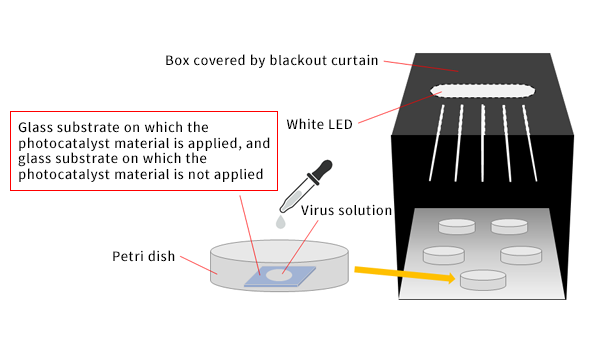Sharp Photocatalytic TechnologyNews
Sharp’s original Visible Light Responsive Photocatalyst material demonstrated to reduce novel coronavirus (SARS-CoV-2) infectivity titer*1 by more than 99.99% in 2 hours.*2
June 23, 2021
Sharp has demonstrated that the visible light responsive photocatalyst material, originally developed by Sharp, effectively reduces novel coronavirus (SARS-CoV-2), by working in collaboration with Professor Hironori Yoshiyama of the National University Corporation, Department of Microbiology, Shimane University Faculty of Medicine (also, a board member of the Japanese Society for Virology).
In the test, drops of the SARS-CoV-2 solution are put on “glass substrate having Sharp photocatalyst material applied” and “glass substrate without it applied” respectively. Then they are irradiated with 1000lx white LED light in a chamber covered by blackout curtain, and respective infectivity titers were measured after 1 and 2 hours.
The glass substrate with the photocatalyst material applied demonstrated the reduction of viral infectivity titer by more than 98% after 1 hour and more than 99.99% after 2 hours, compared to the glass substrate without it applied, demonstrating definite efficacy.
- *1 Quantity of virus with infectivity
- *2 The virus infectivity titer after 2 hours of light irradiation was compared with the sample without photocatalyst.
Overview of verification test
- Testing Organization
- The National University Corporation, University of Shimane, Faculty of Medicine (located in Izumo City, Shimane Prefecture)
- Specimen
- Glass substrate on which Sharp’s photocatalyst material is applied, and glass substrate without it applied
- Light Source
- White LED
- Illuminance
- 1,000 lx
- Validation virus
- Novel Coronavirus (SARS-CoV-2)

Test Method
- Put drops of SARS-CoV-2 solution on both glass substrates with photocatalyst material applied (hereinafter referred to as “Photocatalyst-processed item”) and without photocatalyst material applied (hereinafter referred to as “Non-photocatalyst-processed item”)
- Leave the following 5 specimens under 1,000 lx white LED for specified amount of time, then collect.
- ① “Initial”
- Collect non-photocatalyst-processed item immediately after creating a sample of it.
- ② “Without photocatalyst 1h”
- Leave non-photocatalyst-processed item under white LED for 1 hour.
- ③ “With photocatalyst 1h”
- Leave photocatalyst-processed item under white LED for 1 hour.
- ④ “Without photocatalyst 2h”
- Leave non-photocatalyst-processed item under white LED for 2 hours.
- ⑤ “With photocatalyst 2h”
- Leave photocatalyst-processed item under white LED for 2 hours.
- Inoculate virus solution which is extracted from the specimen to cells and measure virus infectivity titer using TCID50 assay.

(Left: Test chamber, Right: Measuring viral infectivity titer)
Results
Confirmed effectiveness of reducing viral infectivity titer for SARS-CoV-2
| Initial | Elapsed Time: 1h | Elapsed Time: 2h | ||
|---|---|---|---|---|
| Virus Infectivity Titer (TCID50/mL) |
With photocatalyst | 1.0 x 107 | 5.6 x 106 | 1.8 x 106 |
| Without photocatalyst | 1.0 x 105 [98% or more] |
5.6 x 101 [99.99% or more] |
The value in “[ ]” shows the reduction rate of virus infectivity titer compared with non-photocatalyst-processed item (without photocatalyst).


Comments from Professor Hironori Yoshiyama of University of Shimane, Faculty of Medicine
Sharp’s photocatalyst material has demonstrated that it has a powerful antiviral effect in a short amount of time against SARS-CoV-2. This result also offers the prospect of antiviral effect in real use environment. This effect is supposed to be brought by the structural destruction of protein due to photocatalystic action and thus it is believed to exert the same effect on the variant strain as well as the existing strain. Photocatalyst has an advantage that it is not consumed itself, even if it continues to work. So, its application is promising in the society of “during-COVID” and “post COVID”.